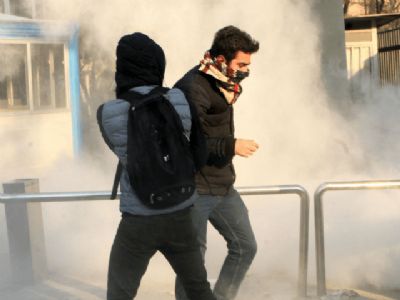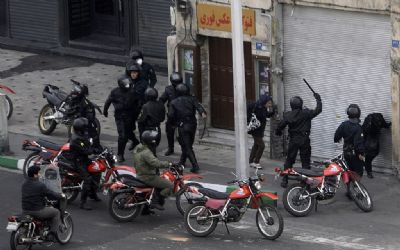Share
What's New
Resources updated Monday, January 1, 2018
January 1, 2018

Iranian Supreme Leader Ayatollah Ali Khamenei blamed Iran's "enemies" on Tuesday for stirring up unrest in the country, as the death toll from days of anti-government protests climbed to 21.
In his first remarks since the demonstrations erupted last Thursday, Khamenei accused the nation's enemies of "joining forces" and blamed them for the protests that have turned violent.
"The enemy is waiting for an opportunity, for a flaw, through which they can enter. Look at these events over the last few days. All those who are against the Islamic Republic -- those who have money, those who have the politics, those who have the weapons, those who have the intelligence -- they have all joined forces in order to create problems for the Islamic Republic and the Islamic Revolution," he said, without naming any particular country.
Key developments
Nine people were killed on Monday, including seven protesters, state media reports, taking the toll to 21.
- 450 people have been arrested in the past three days.
- Iranian President Rouhani slammed US President Donald Trump for tweeting his support for protesters.
- Trump called the Iranian government "brutal and corrupt" in a second tweet Tuesday.
Authorities have restricted the apps Instagram and Telegram but users are accessing them with VPNs.
Days of violence
The protests have become the biggest challenge to the Iranian government's authority since mass demonstrations in 2009. Around 450 people have been arrested over the past three days, according to state media.
The rallies began Thursday over the country's stagnant economy and rising living costs, but they developed into a broader outcry against the government and intensified over the weekend. Many of the protesters are young Iranians tired of the lack of economic opportunity in the country.
Of the nine people killed Monday, seven were protesters. Six of them died in the central city of Qahdarijan when demonstrators stormed a police station and attempted to take guns from authorities, state media reported. The seventh protester was killed in nearby Khomaini Shahr.
A policeman died in Najafabad after a protester shot at officers with a hunting rifle, according to state media. Three other officers were wounded. A member of the Basij, a pro-government militia, was also killed, in south Tehran.
Video images shared on social media from the central city of Tuyserkan on Sunday showed protesters throwing chairs, tables and other objects in reach at riot police, forcing the outnumbered officers to retreat. Six protesters were shot dead in the unrest there, according to the semi-official Fars news agency.
A man and his young son also died on Sunday when a fire truck hijacked by protesters ran them down on a street in western Iran's Dorud, according to the semi-official ISNA news agency. Twelve people were killed over the weekend.
Iranian President Hassan Rouhani tried to downplay the significance of the protests, which have spread beyond the capital of Tehran to at least 18 cities, claiming that "This is nothing" compared to other outbreaks of unrest.
But authorities have nonetheless responded with mass arrests and by restricting the use of the social media apps Instagram and Telegram, used to organize the rallies.
There are now concerns that some protesters could face the death penalty. Musa Ghazanfarabadi, the head of Iran's Revolutionary Court, said Tuesday that some protest ringleaders could be charged with "muharabeh" -- taking up arms against the state -- and accused them of being connected with foreign intelligence agencies, the semi-official Tasnim news reports. The crime carries a maximum sentence of death.
Trump: 'Time for change!'
Trump has repeatedly tweeted his support for the protesters in the past week, criticizing the Iranian government as repressive, "brutal and corrupt."
"The people of Iran are finally acting against the brutal and corrupt Iranian regime. All of the money that President Obama so foolishly gave them went into terrorism and into their 'pockets.' The people have little food, big inflation and no human rights. The US is watching!" he wrote on Tuesday.
Rouhani slammed Trump for a similar tweet Monday in which the US leader said the Iranian people were "repressed" and that it was "TIME FOR CHANGE!"
Secretary of Iran's Supreme National Security Council Ali Shamkhani accused the US, UK and Saudi Arabia of using hashtags and social media campaigns inside Iran to incite riots.
"Based on our analyses, around 27% of the new hashtags against Iran are generated by the Saudi government," Shamkhani said, according to state-run Press TV.
The UK has called on Iran to engage in a "meaningful debate" on the issues raised by protesters, Prime Minister Theresa May's spokesman said Tuesday.
Iran's Supreme Leader blames 'enemies' for protests, death toll hits 21 Document

At least 12 people have been killed in four days of demonstrations in Iran, state media reported, in the biggest challenge to the authority of the Tehran regime since mass protests in 2009.
The violence continued despite an appeal for calm by Iranian president Hassan Rouhani on Sunday. He played down the significance of the protests on Monday, as the country's leadership struggled to respond to the largely spontaneous uprisings.
"Our great nation has witnessed a number of similar incidents in the past and has comfortably dealt with them. This is nothing," Rouhani said in a meeting with Iranian MPs on Monday. But he acknowledged that Iranians had legitimate concerns and had the right to make legal protests. The protests have stemmed from concerns about rising living costs and a stagnant economy, but have developed into a broader-based outcry against the regime.
They are the most serious challenge to Tehran's authority since the so-called Green Movement of 2009, when millions marched in the capital to protest the election of President Mahmoud Ahmadinejad, accused by the opposition of being rigged.
So far, the latest unrest is on a much smaller scale than 2009. Authorities have yet to launch a wide-ranging crackdown, as they did eight years ago, preferring instead to contain the protests locally.
Iran's state broadcaster said six people were killed in the small western town of Tuyserkan on Sunday, according to Agence France-Presse (AFP).
Also on Sunday, two were shot dead in the southwestern city of Izeh, the area's local member of parliament, Hedayatollah Khademi, told the semi-official ILNA news agency. Khademi said he did not know whether the shots were fired by security officials or protesters, according to the report.
Izeh is in the oil-rich southern province of Khuzestan, just south of the Lorestan province where two other Iranians were killed in protests on Saturday evening.
The deputy governor of Lorestan province, Habibollah Khojastehpour, denied that security forces had fired any bullets, blaming "Takfiri" groups and foreign intelligence services for the clashes.
Another two people were killed Sunday in the city of Dorud after a fire engine was hijacked, the semi-official ISNA news agency reported, citing the local governor.
At a meeting with MPs on Monday, Rouhani acknowledged that Iranians had the right to protest legally. "The space needs to open up for legal protest and criticism," he said, echoing remarks he made in a pre-recorded appeal for calm aired on state TV Sunday.
In a nod to the concerns fueling the protests, he added: "We have no bigger challenge than unemployment. Our economy requires major corrective surgery."
Earlier, state-run media outlet IRIB reported that officials had temporarily restricted access to social media apps Instagram and Telegram, which have been used by Iranians to share news about the protests. Iran's Minister for Communications and Technology Azari Jahromi denounced the reports as "rumors" in a post on Twitter Monday.
Social media has helped galvanize tens of thousands participating in the protests, which have taken place in towns and cities across Iran. The unrest appears to have begun with hardline agitators encouraging protests against Rouhani. But they quickly lost control of events and demonstrations have taken on a general anti-regime feel.
In a rare act of defiance, some protestors have even called for the resignation of Supreme Leader Ayatollah Khamenei.
In some demonstrations, women cast off their hijabs, defying the country's strict Islamic dress code. The protests have provided an opening for Iranian women to push for equal rights - something they've been fighting for over decades.
Video shared on social media captured Iranians chanting "We don't want an Islamic Republic" and "Death to the dictator." CNN has not independently verified the authenticity of the footage, purportedly shot in the western city of Khorramabad.
US President Donald Trump voiced his support for the demonstrations in a series of tweets on Sunday. He posted: "The people are finally getting wise as to how their money and wealth is being stolen and squandered on terrorism. Looks like they will not take it any longer. The USA is watching very closely for human rights violations!"
He weighed in again on Monday, posting: "Iran is failing at every level despite the terrible deal made with them by the Obama Administration. The great Iranian people have been repressed for many years. They are hungry for food & for freedom. Along with human rights, the wealth of Iran is being looted. TIME FOR CHANGE!
Rouhani, who won re-election in May, said in his Sunday speech that Trump had been at the root of many of Iranians' woes, "constantly creating problems" for people in the country since he entered the White House.
At least 12 dead as Iranian regime faces biggest challenge in eight years Document
